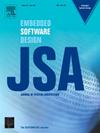Secure and privacy-preserving quantum authentication scheme using blockchain identifiers in metaverse environment
IF 3.7
2区 计算机科学
Q1 COMPUTER SCIENCE, HARDWARE & ARCHITECTURE
引用次数: 0
Abstract
The metaverse, a collection of virtual worlds offering a variety of social activities mirroring real-life interactions, is garnering increasing attention. Consequently, the need to ensure security and privacy within these spaces has become paramount. Metaverse users can create multiple avatars, a feature that can be exploited to deceive or threaten others, leading to significant internal security concerns. Additionally, users in the metaverse are susceptible to several external security threats due to the public nature of their communications with service providers.To address these challenges, we propose a novel quantum authentication scheme leveraging blockchain technology, decentralized identifiers, and verifiable credentials. This scheme enables secure identity verification and authentication for metaverse users. By allowing users to independently prove their identity without relying on service providers, the proposed approach mitigates privacy concerns associated with the management of personal information. Furthermore, our scheme achieves mutual authentication between the user and the service provider, while also being resilient against a variety of attacks, including unconditional security breaches, replay attacks, eavesdropping, man-in-the-middle attacks, and impersonation attempts. With a computation time of 17.4608 ms and a communication cost of 872 bits, the suggested protocol outperforms current solutions and provides superior security for the metaverse environment during data transmission and storage. Furthermore, we examine the operational capabilities and security features using the latest technology and techniques.
求助全文
约1分钟内获得全文
求助全文
来源期刊

Journal of Systems Architecture
工程技术-计算机:硬件
CiteScore
8.70
自引率
15.60%
发文量
226
审稿时长
46 days
期刊介绍:
The Journal of Systems Architecture: Embedded Software Design (JSA) is a journal covering all design and architectural aspects related to embedded systems and software. It ranges from the microarchitecture level via the system software level up to the application-specific architecture level. Aspects such as real-time systems, operating systems, FPGA programming, programming languages, communications (limited to analysis and the software stack), mobile systems, parallel and distributed architectures as well as additional subjects in the computer and system architecture area will fall within the scope of this journal. Technology will not be a main focus, but its use and relevance to particular designs will be. Case studies are welcome but must contribute more than just a design for a particular piece of software.
Design automation of such systems including methodologies, techniques and tools for their design as well as novel designs of software components fall within the scope of this journal. Novel applications that use embedded systems are also central in this journal. While hardware is not a part of this journal hardware/software co-design methods that consider interplay between software and hardware components with and emphasis on software are also relevant here.
 求助内容:
求助内容: 应助结果提醒方式:
应助结果提醒方式:


